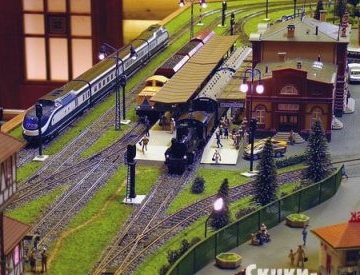I want to note at the very beginning that the products that will be discussed and which subsequently turn into layout, known in the post-Soviet space since the late 60s of the last century. It happened historically (I mean the history of modeling and prototyping) that Germany and Austria focused their interests and efforts on the production of models of the railway industry specifically. These are all kinds of classic and modern locomotives - steam locomotives, diesel and electric locomotives, wagons and platforms for them. Other countries, such as France, surpassed the rest in the production of kits for assembling aircraft models, especially they succeed in the planes of the Second World War.
Paying attention to trains allowed developing an unlimited range of products. Only one artificial grass for covering layouts, there are about 40 species. In addition, there are various powders imitating crushed stone, fallen leaves, plowed soil, sprouted seedlings, etc. Formulations have been developed for creating water sources - as a rule, these are gels and gelling masses with a dye content. So, having made a notch in the lower levels of the layout, you can pour pebbles (also by the way a lot of species) and pour gel on top - the lake is ready on the layout.
To create an imitation of bushes and trees, natural materials are also used - moss, horse hair (for reeds and swamp thickets). In most cases, for reproduction of foliage of trees, specially painted parallon and other elastic synthetics are used.
Residential buildings, industrial buildings, and various small items (such as streetlights) are supplied either assembled or disassembled in individual packaging. Thus, before you take up the layout itself, you must first glue the houses, bus stops, factories, a railway depot and much more.
PIKO, Roco, Noch, Auhagen products are mainly supplied to Russia. The first two specialize mainly in the production of rolling stock, Noch makes wonderful trees, lanterns, powders for powder and grass.Auhagen makes houses and constructions more advantageous than other houses, for example bridges.
The most popular scale for creating railroad layouts is H0 1:87. This is not too large and not too small. It is large enough to make it possible to make out all the smallest details on steam locomotives and buildings, but small enough to afford a model of a house or office. Over 50 years of the history of the development of the layout of railways electronic the filling stepped far forward. Management has become digital rather than analog as before. Those. Now a voltage of 14 volts is supplied to the rails, and various signals are transmitted through it to locomotives. Previously, it was only possible to adjust the speed - raising and lowering the voltage. Now you can change the direction of movement, give sound signals, accelerate and slow down - and all this with an infrared remote control.
The second most popular is the suitcase format 1: 120. These are the so-called hiking options. Locomotives and buildings are not so well detailed yet recognizable.
If you are in thought, what to do in your free time and what to teach children - I want to warn you - railway modeling - Passion is not cheap. For example, a couple of bus stops cost 250 rubles, a steam locomotive and a couple of wagons complete with a control unit - at least 6,000 rubles, but I don’t even dare say how much artificial grass and trees will go. If on a vskidka, then for a 1 by 2 m layout you will need about 60 thousand rubles. And it is unlikely that this will end. You will constantly buy something - fountains, newsstands, viaducts, watches, etc. to decorate your miniature city. Railway modeling is very addictive and if you took up layout creation - Be prepared to deny yourself anything else.
A.V. Kozhekin
Designer, Modeler
Designer, Modeler

